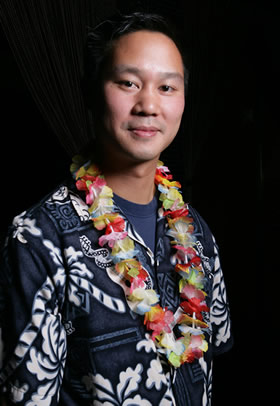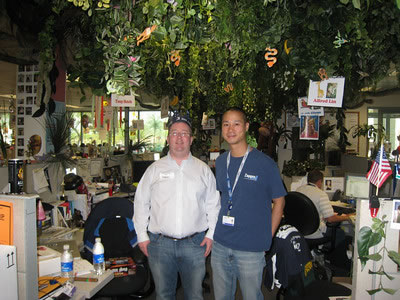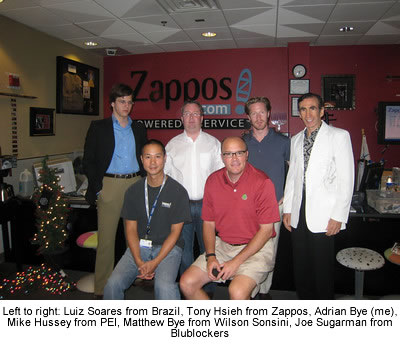
Tony Hsieh is the CEO of Zappos. They’re on track to do $1 billion dollars this year, all online. Tony previously founded LinkExchange which he sold for $265M to Microsoft in 1998. While Zappos started by selling shoes, Tony shares how Zappos’ focus is really on the customer experience and customer service it provides. Tony talks about how he went from investor to full-time employee at Zappos because it was really taking off, and as Tony said, seemed fun.
Full Interview Audio and Transcript
Personal Info
Hobbies and Interests: Watching Movies, Playing Poker.
Favourite Sports Teams: No Sports.
Favourite Books:
- Peak: How Great Companies Get Their Mojo from Maslow by Chip Conley
- The Tipping Point: How Little Things Can Make a Big Difference by Malcolm Gladwell
Favourite Entrepreneurs: Richard Branson (Virgin).
Personal blog: http://blogs.zappos.com/blogs/ceo-and-coo-blog
Twitter URL: http://twitter.com/zappos
Company Website: http://zappos.com
Fast Track Interview
Adrian Bye: Today I am talking with Tony Hsieh from Zappos. Tony, we’ll talk about how you became involved with Zappos and where the company is today, but let’s start by talking about your company LinkExchange.
Tony Hsieh: In 1996, I co-founded LinkExchange with a college roommate, and we grew the company to 100 employees. It was basically a cooperative advertising network. We provided free advertising services to about a million different Web sites in our network. In 1998, Microsoft bought the company for $265 million. They acquired it to access the small businesses on our network as they launched their small business initiative.
After that, I formed a small investment fund called Venture Frogs with Alfred, who I had worked with previously. We invested in 20 or so different Internet companies. Zappos happened to be one of them. Over time, it became evident that Zappos was the most promising and the most fun. Eventually, I decided to join the company full time, and I became the CEO.
Adrian Bye: How did you go from investor to full-time employee?
Tony Hsieh: Initially, we thought it would be fun to be involved in a lot of different companies. What I found was that I missed being a part of the creative process to help grow a company. When you invest in companies, you put in the money and occasionally are an adviser, but you’re not really involved in the day-to-day.
There wasn’t a day where I just suddenly transitioned into Zappos. I ended spending more time with the company. It wasn’t something that I forced myself into. Instead, it was something that seemed like it made sense to everyone involved.
Adrian Bye: How did Zappos start?
 Tony Hsieh: In 1999, all types of different Internet companies were being started. At the time, shoes didn’t sound like a great idea to me, but I learned that in the United States it was a $40 billion market and five percent or $2 billion was being done by paper mail-order catalogs. It definitely seemed the Web would be as big as paper mail-order catalogs.
Tony Hsieh: In 1999, all types of different Internet companies were being started. At the time, shoes didn’t sound like a great idea to me, but I learned that in the United States it was a $40 billion market and five percent or $2 billion was being done by paper mail-order catalogs. It definitely seemed the Web would be as big as paper mail-order catalogs.
Over time, customers found it was very easy to purchase from us. We started adding more customer-friendly services. For example, we offer free shipping both ways, which removes a lot of the risk of buying shoes online. We started extending our return policies from 30 days to 60 days to 90 days. Today, it’s 365 days.
We hadn’t planned all of those things from the beginning. However, we found that as we put more into the customer experience and customer service, it helped fuel our growth of repeat customers and word-of-mouth. That’s how we started with zero sales in 1999. This year, we are on track to do a little over a billion dollars in gross merchandise sales. Long term, we want the Zappos brand to be about the very best customer service.
Adrian Bye: Zappos was started in the Bay Area, but now you are located in Las Vegas. What prompted the move?
Tony Hsieh: Our customer loyalty team, which is our call center, was our fastest growing department. In San Francisco, it’s really hard to find people who want a career in customer service. Vegas is the 24/7 city, and we run our call center 24/7. It’s also much more affordable than San Francisco, and a place where customer service can be seen as a career.
We didn’t want to open a call center in Vegas and then keep our headquarters in San Francisco. If our brand is about providing the very best customer service, then customer service needs to involve the entire company not just the department. We all needed to be located where the customer service happens.
Adrian Bye: How do you run things internally to guarantee your focus on customer service works?
Tony Hsieh: We do a number of different things. Some of it is our policies, such as the free shipping. Some of it is showing that we truly want to talk to our customers. For example, on most Web sites, it can be difficult to find contact information, especially the phone number. Our 1-800 number is at the top of every single page of our Web site.
Most call centers measure how many customers the reps talk to in a day, which translates into how quickly you can get the customer off the phone. We do not view this as good customer service.
We don’t even measure call time. All we care about is if the rep went above and beyond for the customer.
For example if the customer calls us looking for a specific pair of shoes and we’re out of their size, we will research at least three other competitor Web sites. If we find it there, we will direct the customer to the competitor. Yes, we’ll lose the sale, but it is better customer service. It’s making sure every interaction we have with the customer results in them saying, “That was the best customer service I have ever had.”
Adrian Bye: How do you handle extreme situations when customers try to take advantage of your policies?
 Tony Hsieh: If customers are clearly abusing our policies, we’ll call the customer. For example, we’ll let them know that returned shoes need to be in new condition. For example, they cannot use the shoes for hiking and then return them. If those situations happen repeatedly, we will disable the customer’s account.
Tony Hsieh: If customers are clearly abusing our policies, we’ll call the customer. For example, we’ll let them know that returned shoes need to be in new condition. For example, they cannot use the shoes for hiking and then return them. If those situations happen repeatedly, we will disable the customer’s account.
We are not trying to be all things to all customers. For example, we want customers to come to us for the best service and the best selection, but there are plenty of customers that are simply looking for the lowest price. We’re not going to make those customers happy because we don’t offer coupons or blanket promotions.
In other words, we do not compete on price. We want customers that value better service and are willing to pay a little more for that. If the customer wants to shop somewhere else because of a lower price, then they are not the right customer for us.
The initial reason a lot of customers first try us is because of our selection. We have a much larger selection than you’re able to find in any brick-and-mortar store. Our warehouse, which is two buildings, is the size of 17 football fields with a little over four million items. We work with over 1,500 different brands. You’ll find more styles available on Zappos.com than you would in any specific brand’s own store.
We will encourage customers to order two sizes if they are not sure whether a size 81/2 or 9 will fit best in a particular brand. They can return the size that does not fit. It’s free shipping in both directions, which is convenient and risk-free for the customer.
Adrian Bye: What percentages of the shoes are returned?
Tony Hsieh: It varies by brand. For some brands, the return rate might be 20 percent; other brands might be 40 percent. The more expensive shoes are most likely to be returned. In some cases, the returns are because the shoes do not fit.
Adrian Bye: What percentage of people place orders on the phone versus online?
Tony Hsieh: Roughly five or six percent of the orders are placed through the phone, but most of the phone calls are not customers placing orders at that moment. On average, every customer will contact us by phone at least once in their lifetime. They could need shopping advice. It could be that a customer needs help with going through the return process for the first time. Right now, we receive about 5,000 phone calls a day.
Adrian Bye: Do you ever get on the phones yourself and take calls from customers?
Tony Hsieh: Yes. It’s not just me though. Everyone that is hired in our Las Vegas office goes through a 5-week training program. During this program, we review the history of the company, the importance of customer service, and the focus on company culture. Each new employee also learns how to use the customer service tools. For example, they take customer service calls for one of the weeks in the training program. Then we’ll send them to our warehouse in Kentucky where they will do all the different warehouse functions: picking, packing, shipping, receiving, and such. After that, they start the job for which they were hired, whether it is as a lawyer or accountant, for example.
We believe very strongly that customer service needs to be understood by the entire company. If a software engineer doesn’t make it through that 5-week program, then we won’t hire that person. It gets everyone on the same page in terms of our culture and our customer service focus. The other nice aspect is that during our busy season in the fourth quarter anyone from any department can jump on the phones.
Adrian Bye: How did you learn the call center business?
 Tony Hsieh: We learned and worked things out as we went along, and all of our call center software is built in-house. It has been a constant evolution. We add features almost on a daily basis as a result of feedback from our reps and customers.
Tony Hsieh: We learned and worked things out as we went along, and all of our call center software is built in-house. It has been a constant evolution. We add features almost on a daily basis as a result of feedback from our reps and customers.
Adrian Bye: What are you doing about international orders?
Tony Hsieh: Long term, we plan on expanding into different countries, but for now we’re focused on North America. We have so many other opportunities here in terms of product categories. Also a lot of people in the United States have never heard of Zappos. Rather than spread ourselves too thin by trying to be in a number of countries at this stage of the company’s growth, we have decided to focus on North America and do the best possible job we can here. Once we have accomplished that, we will start expanding into other countries.
Adrian Bye: How do you acquire customers? Is it through referrals, viral marketing, affiliate programs, and media buying, or do you only focus on word-of-mouth?
Tony Hsieh: No, we do have paid advertising; most of our paid advertising dollars are spent online. The top two forms are buying keywords and our affiliate program. We have an account on Commission Junction, and anyone can sign up for our program as long as it’s an appropriate fit. We pay a straight percentage. Right now, our affiliate program payout is 12 percent of the net sales that happen within the first 90 days of driving a customer to our Web site.
We don’t exactly have an advertising budget. We think of it more in terms of a ratio. For every dollar we spend in advertising if we get so many dollars in sales, it’s going to pay for itself on the first order. While we could spend as much money there as possible, there is a limit to how much we can spend while still meeting that criteria. That’s why we have decided to focus on trying to drive word-of-mouth and repeat customers.
Adrian Bye: Are you testing landing pages, split testing, doing e-mail sign ups, and sending updates to convince people to buy?
Tony Hsieh: Yes, we do a little bit of those things. Different keywords will have different ROIs associated with them, and we will look at that as well. The main focus of the company has been and will continue to be on what we can do to make the customer service and customer experience better.
Adrian Bye: And your reason for that focus is to keep the value high so customers are happy and will return to buy more shoes?
Tony Hsieh: Yes. Then over time customers will slowly learn we also sell clothing, handbags, and items from other product categories. It will take some time for our customers to think of us beyond shoes.
Adrian Bye: Where are your future key products?
Tony Hsieh: In the long term, the Zappos name will be about the best service. We’re already selling handbags and clothing. We just recently added electronics, cookware, luggage, linens, sporting goods, and watches. We’re open to experimenting with a lot of different things. Then it will depend on what customers gravitate towards. The direction we can go is limitless.
Adrian Bye: How profitable is the company?
Tony Hsieh: For the last several years, we’ve been running the company close to breakeven. Basically, any money we made has been put back into the customer experience. For example, we used to ship everything ground. When we could afford it, we surprise-upgraded people to three-day shipping. Then we surprise-upgraded people to two-day shipping. Now we surprise-upgrade everyone to overnight shipping.
Last year was the first year we made a significant profit. It was roughly a five percent operating profit off of our net sales. We plan on continuing to grow the company and run it profitably. This isn’t a company we’re trying to grow and sell. We definitely are thinking in the long term.









